|
Industrial Logic
|
3 Safe Place **
. . . a good physical environment (COMMON GROUND, PUBLIC LIVING ROOM) is vital for any study group. Equally vital, is the intellectual environment, which this pattern describes.
Loud-mouths, show-offs, know-it-alls and people who are overly competitive,
adversarial or confrontational, can make others uncomfortable
or insecure, and create an environment that is not conducive to
learning, sharing or the building of ideas.
It is so important that a place of learning be a safe place. People
need to feel that they can experiment, or be wrong, for almost everyone
becomes uncomfortable if they fear that anything they say will be harshly
criticized. When places of learning have highly critical or judgmental natures,
an individual's ability to learn can easily be compromised.
In dialogue, participants must be comfortable to ask questions, even illogical, overly simple,
or silly questions. It is the group's task to handle such questions
in such a way that individuals aren't stifled, or embarrassed, but
encouraged to continue learning.
When people are comfortable to admit that
they don't understand something, real learning can happen. And
when someone has the courage to admit that they don't understand, others
are grateful, for often they were a bit unclear about a passage as well.
All participants within a dialogue need to help establish the safe place.
Usually, it is up to the MOTIVATED MODERATOR
to be especially vigilant. With great diversity in a group--people who are
provocative or reserved, skeptical or generous, newcomers or veterans
--it is very easy for study group sessions to become unsafe.
Treating each other with respect, despite differences in opinion, is
essential in the establishment of safety, as Peter M. Senge observed
in The Learning Organization:
For instance, it is quite common for arguments to break out during a dialogue. This can make some people uncomfortable, while it will excite others. Generally, as long as the people arguing are remaining civil towards each other (i.e. they aren't yelling or being impolite), and as long as the argument isn't too far off the subject being studied, it can be quite instructive for a group to listen and learn. But it will help if people understand that passionate arguments are part of a group's local customs, and not something the group has decided to discourage. One problem arises if participants don't realize that they are the ones creating the hostile, unsafe environment. These people may mean well, but may not understand how their words are affecting others. So how does a group deal with such an individual? Usually, it is best for someone who is intimate with the group's customs to approach the individual during a short break or AFTERHOURS, to discuss their behavior and its effect on members of the group. Therefore: Establish a warm, tolerant, polite and focused environment in which individuals help each other and where everyone is comfortable to ask questions and make mistakes.

vvv In practice, there will always be some level of personality conflicts or discord within a group. It can help if people get together after a session (AFTERHOURS), to talk about the issues. . . . |
4 Enduring Energy **
. . . this pattern identifies what is needed in a study group to bring it to life, and sustain it over time.
It's fairly easy to start a study group. But keeping it going, so that members are active, dialogues are insightful, and the group is long-lived, is another matter altogether.
A study group's energy initially comes from its founder. If the
founder is genuinely interested in creating a thriving, long-lasting
POOL OF INSIGHT, to improve himself
and his community, the group will start life with a powerful energy.
But if the founder is merely interested in short-term gains, or
personal recognition, the group will be short-lived.
In considering the long-term vitality of the group, there are many decisions to make.
Where will the group meet? How long will its meetings be? What will be studied?
If poor or uninformed decisions are made about these issues, a group
may never take root or be long-lived. In practice, either an experienced
founder, or a founder and his group, need to patiently consider the best
options and what will add the most life to the group.
One of the most important issues to consider is the frequency and
duration of a group's meetings. The following represent best-practices:
Equally important, is a goup's meeting quarters, since the location
and space will play a huge role in sustaining a group's energy.
People need to be excited about attending a group. And yet, how can they
get excited if the group meets in a dull, stuffy, maybe windowless,
conference room?
Places that attract people -- spacious, comfortable, energetic places --
make the difference: groups bond there, people want to be there,
and somehow, even the atmosphere helps dialogues gain life.
Groups also gain or lose energy based on the quality of the
literature they study. If a group studies a great piece of
literature, chances are they'll have a great dialogue. But if
they study a poor, uninteresting piece of writing, usually, their
dialogue will be lifeless and stale. Each member of a group must
therefore research or review any writings which they propose for study.
Therefore:
Create study groups out of genuine enthusiasm to study a subject in-depth. Meet weekly or bi-weekly for two hours, and have a short break in the middle. Choose a meeting location where people will enjoy passing time, and study only those writings which are worthy of the group's attention.

vvv
For an ideal meeting environment, look for
COMMON GROUND and a
PUBLIC LIVING ROOM.
Create SUBGROUPs and STUDY CYCLEs
to let people place their energy where they best see fit. And
when group energy is low, have a DISTINGUISHED PARTICIPANT
join the group for an evening.
It is a custom of some groups to go out after meetings
(AFTERHOURS), to partake in food and drink.
This social time can go far towards sustaining relationships
and adding energy back to a group. . . .
|
5 Kindred Collaborators *
. . . When a study group has an ENDURING ENERGY, people get to know each other, a community forms, and there is a lasting possibility for collaborations and working relationships.
So many people dislike networking. They want to grow professionally, and they think that networking can help, but they don't know how, where and with whom to network effectively.
Many people feel isolated in their jobs. So much of their time is spent
working that there is little time left to pursue what genuinely interests them.
To counter this, some try to organize study groups within their own
companies. This may have some success, but often it fails due to lack
of interest, or because many people prefer to be outside of work
when they have any free time.
Some people go to conferences, lectures, user groups and parties in the hope of advancing
their careers and themselves. Often, they end up frustrated -
in reality, they don't grow professionally at these meetings, and their networking is ineffective.
The trouble often results from what may be described as weak connections that develop between
people who meet in large groups.
Contrast this with what happens in an intimate, frequently meeting
study group. In such a group, people get to know each other over time: They learn what they like and
dislike, what they excel at and where they are weak, where they are in their
careers and where they'd like to go. This level of familiarity forms the
foundation for a rich network that can yield very real career
and collaboration possibilities.
Such an environment may be particularly useful to those who need to dynamically build
effective teams to work on specific projects. As one gets to know others within
a group, one can get a very good idea of who would be good for specific projects.
Therefore:
Join or form a small group that meets regularly and studies ideas that are important to you. As you get to know people, valuable, career-enhancing collaborations will develop.
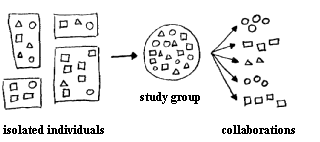
vvv Quality networking happens best when a study group is a SAFE PLACE composed of diverse individuals and true peers. The best time for networking is either before a study group meets or AFTERHOURS. . . . |
|
6 Common Ground **
. . . where a study group meets is nearly as important as how the study group runs and what it studies. This pattern helps direct the initial attempt at finding a suitable location.
People lack a place where they can have regular, meaningful dialogues with other people in a casual, social setting. Work and home don't provide it, and many clubs or groups also don't provide it because they meet in lifeless environments that feel like someone else's turf.
A pregnant woman reported that she was invited to participate in
a regular discussion group with other pregnant women at a local
hospital. While she was interested, she was repelled by the
thought of spending copious time in a
hospital. She also related that she was looking for something
a little more human in scale, not something sponsored by a huge organization.
As this case points out, people want to connect with others but aren't
willing to do so in settings that make them feel uncomfortable.
Location plays a vital role in the life of a group.
In the early days of the Design Patterns Study Group, the meeting
location was in a small apartment located on Manhattan's Upper West
Side. This location was great for some members of the group, but
not very good for others, especially those coming from New Jersey,
who had long commutes and problems finding parking. The location was
quickly changed to a spacious cafe in SoHo, a more central part of
the city, which represented a midpoint for nearly all members of the group.
Howard Schultz, chairman and CEO of Starbucks, noted the importance of comfortable meeting places in his book, Pour Your Heart Into It:
It can take time to find a place that will be comfortable and serve as common ground for a diverse group of people. But there are clearly some types of places to avoid. For instance, when individuals who work in large office buildings decide to form groups, they often consider using one of their company conference rooms as a meeting location. This is a perfectly natural choice, since the room may be spacious, quiet, filled with white boards, available after hours, and free. However, such rooms are rarely good choices because people -- both employees and visitors to the company -- generally don't like to spend their free time in stuffy, stale, office environments. Over the years, New York's Design Patterns Study Group has been offered meeting locations in numerous corporate offices, all of which lacked the charm, convenience, and expansiveness of the SoHo location. Since study groups meander between learning and hanging out with peers, they are best located between member's offices and homes. If they're too close to or too far away from member's offices or homes, individuals will consistently miss meetings, show up late, or leave early. Therefore: Hold public study groups where diverse individuals will all be on common ground. The best locations are easy for people to get to, but not too close to their offices or homes.
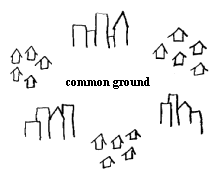
vvv Once common ground has been selected, a group must find a PUBLIC LIVING ROOM: a comfortable, relaxing, dialogue-friendly place. . . . |
7 Public Living Room *. . . consider now the character of the study group's COMMON GROUND. What will the space provide to make people comfortable and foster great dialogue?
Inhospitable physical locations - stale, lifeless, badly lit, and uninviting - stifle individuals and thereby hinder lively, engaging dialogues.
Great locations for study groups resemble large, comfortable living rooms.
There are various types of chairs that may be rearranged, perhaps a sofa and rugs,
some lamps or other warm lighting, and windows. When people feel comfortable
they forget about themselves and may freely engage in dialogue.
Some of the best locations are quiet, aesthetic places that
invite reflection: a centrally located cafe, a spacious gallery or
bookstore, a room with a magnificent view, or some nook or corner
of a hotel or lodge.
All great meeting places exhibit certain physical patterns, which
are thoroughly and beautifully described and depicted in
the book A Pattern Language [Alexander+1977].
One pattern, called Sitting Circle, helps people understand how to arrange
furniture to best accomodate small groups:
Dialogues also tend to be more alive if the lighting around the meeting tables is good. Pools of Light, another pattern from A Pattern Language, advises people to look for places that "place the lights low, and apart, to form individual pools of light which encompass chairs and tables like bubbles to reinforce the social character of the spaces which they form."

a cafe in San Francisco Groups that grow in numbers will need a certain amount of space. So the best locations will let groups grow by accommodating the formation of SUBGROUPs, seated in INTIMATE CIRCLEs. Great locations also allow members to show up before a dialogue begins, or linger around after it ends. And since members often arrive late, leave early, get up for snacks or use the restrooms, the best places allow traffic to flow with minimum disruptions. Therefore: Choose a warm, spacious establishment where people will enjoy mingling before and after study sessions, where there is comfortable, rearrangeable furniture, plenty of warm lighting, and a variety of foods and drinks.
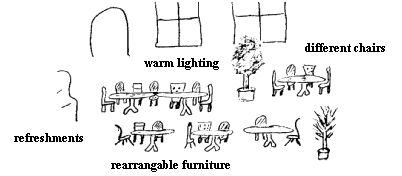
vvv
Some public places may be perfect in nearly every way except one:
they may be too noisy at certain times of day, or you can't
guarantee that there will be enough seating. Faced with these
constraints, some groups may choose to reserve space or arrange to meet
at a location when it closes to the public.
Communication between members will be greatly enhanced with a
VIRTUAL SPACE. . . .
|
8 Intimate Circle **
. . . this pattern helps groups understand how to arrange furniture and space within a PUBLIC LIVING ROOM to create a communications-rich dialogue environment.
Awkward seating arrangements alienate people and thwart a group's ability to work together. The best configurations allow participants to easily see and hear each other. Yet many establishments don't provide either the furniture or space to make this happen, or don't let groups rearrange the furniture.
A group's ability to have a good dialogue is closely tied to the physical
arrangement of the group: if people are too spread out, too close together,
or on the outer edge of an inner group, communication between participants suffers.
people at opposite ends of table can't communicate very well

people are too close for comfort The best seating arrangements let groups form rough circles or ovals, around which all participants may effectively communicate. The circle will often need to grow or contract as members arrive and depart. To accommodate this, a group will need to choose a meeting location that has many tables and chairs, which may be rearranged at will. This is important for supporting SUBGROUPs, particularly when they need to be formed spontaneously, due to a large influx of participants. The author's of A Pattern Language discuss group spaces in a pattern called SMALL WORK GROUPS:
Therefore: Choose a location with ample room, many tables and chairs, and the freedom to rearrange the spaces to form rough circles or ovals that may dynamically expand or contract.

vvv A Pattern Language contains numerous patterns that will help to complete an INTIMATE CIRCLE: WORKSPACE ENCLOSURE describes how to create an atmosphere in which people can work effectively, particularly in small groups. SITTING CIRLCE describes good physical layouts for groups. |
9 Virtual Space **
. . . COMMON GROUND and PUBLIC LIVING ROOM established a physical center for the study group. This patterns expands that center by giving people an online gathering place.
Without an online presence, a study group will lack a cost-effective way of advertising its existence, organizing events, staying connected and attracting new members.
Since Web sites are inexpensive to create and easy to build, they are
perfect for study groups. A good site will define what a group is about,
who is part of the group, what the group is studying, and
when and where the group meets.
The trick to building a good site, is to avoid loading the site with
too much content that will regularly change, and to enlist the group's
participants to maintain the content that will need routine updating.
If the study group keeps a DISTRIBUTED DIARY or provides
feedback to authors, it is a good idea to post this material to the site,
for the edification of group members, and to foster online dialogue.
For conducting such dialogues, a simple, group email server or service (such as eGroups)
is useful.
AGENDAs are particularly helpful for members and
non-members of a group and are therefore best placed on the site. A good
agenda will span several months, giving people the chance to plan their
schedules and study readings prior to group meetings (PREPARED PARTICIPANT).
A good site will post links to related sites, along with a recommended
reading list. To advertise the group, the site will need to be registered
with search engines, and pointed to by other, related sites.
Therefore:
Establish an online presence where the study group's mission, activities, and DISTRIBUTED DIARIESs are posted, where members may continue dialogues, or chat, and where prospective members may learn more about the group.

vvv A group's virtual space need not be fancy, ought to load quickly (i.e. for people with slow connections to the Internet) and be easy to navigate. |
|
10 Enthusiastic Leader **
. . . a study group needs leadership to have an ENDURING ENERGY and be a SAFE PLACE. This pattern describes what a leader will do to produce these qualities.
When a group doesn't have a leader who is passionate about the subject and determined to nourish and maintain its energy and culture, a group can languish, and possibly not survive.
A group needs someone who can see what a group needs and
synthesize the interests and needs of diverse members.
This isn't easy to do.
The best leaders are those who are genuinely enthusiastic about
a group's mission. Such individuals will lead by example and seek
to make the group thrive, through continuous improvement.
Good leaders will help new members learn how the group runs
and what it expects from members. They will be receptive to
individual problems and work to resolve them.
Leaders will help ensure that AGENDAs are
kept up to date, and that the readings being selected are
worthy of the group's attention.
To inspire a group, a leader may plan special events
at which authors or leading scholars visit and
participate in dialogues (DISTINGUISHED PARTICIPANT).
To help keep a group informed and to attract new faces, a leader will
help produce an informative Web site
(VIRTUAL SPACE) and will encourage others
to invite new members to the group.
Should other groups attempt to subsume the group, the leader will step in
to either prevent a take-over or to explore the idea with the group.
If a group's meeting location is no longer working for a group, the leader
will work with others to help find a more suitable location.
Therefore:
Lead study groups by example and with enthusiasm. Make them places where people want to be, and invite the greater community to participate. Energize members with stimulating events, virtual dialogues, and seek to continuously improve the group by listening closely to member's ideas.

vvv Leaders sometimes can't lead for various reasons. If this is short-term, it usually isn't a problem. But if the group becomes leaderless for some time, someone must step into the role. An ACTIVE PARTICIPANT, who is already enthusiastic about a group, is usually a good choice. However, it is always best if individuals volunteer for roles. . . . |
11 Motivated Moderator **
. . . the way a dialogue is directed plays a huge role in the educational experience of participants. If it's done poorly, the dialogue will be neither a POOL OF INSIGHT nor a SAFE PLACE. This pattern describes what kind of direction will help produce valuable educational experiences.
Without a moderator, dialogues may wander aimlessly, arguments may erupt, people may talk on top of each another, and a group may fail to ever explore an author's deeper meanings.
Most people come to a dialogue hoping to gain a better understanding
of a reading. This objective is not something that groups naturally
follow. In fact, leaderless dialogues often seem to deteriorate into
tangential discussions or multi-person side-conversations.
They also get caught up in trivialities. People choose passages and
spend too much time talking about them, and not enough time trying to
understand the larger issues in a reading.
Then, there are those who don't come prepared. These people have a
tendency to speak about related works which they have read. Meanwhile
individuals who did prepare, can't discuss the reading with those who
did not prepare, and consequently learn very little.
Finally, as we noted in SAFE PLACE, unproductive
behavior can easily surface during a dialogue, and if unchecked,
can easily hinder people's ability to communicate at all.
Effective moderation adds some necessary direction to a dialogue, and
installs a safety net.
When it's done well, it is done with a light touch:
The moderator guides the dialogue where necessary, but doesn't intervene
too much. Even if two people have a passionate argument, a good moderator
will not interfere, if he perceives that the argument is instructive
to the group.
Highly experienced moderators can truly make dialogues great.
This is especially true if the individual is experienced in their
field, adept in the art of moderating, and knowledgeable
about the literature over which they moderate.
Members of a group must ensure that they are familiar with the role of
moderator before volunteering to play the role. The following practices
define what good study group moderators do:
Therefore:
Moderate dialogues by asking penetrating questions, keeping dialogues focused, balancing diverse personalities, and helping group's increase their understanding. Give all members a chance to moderate, but let them choose when they want to play the role.
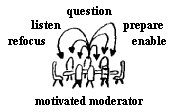
vvv
It can take time to become adept at moderation, since it involves
actively speaking, listening, and observing. One must also prepare
thoroughly, if one is to make the proper decisions about when to
intervene in a dialogue or dispute.
|
12 Active Participant **. . . the ENTHUSIASTIC LEADER works to make a study group an active learning environment. But they can't do it alone. This pattern describes what each participant must do to make the study group work for them.
Anyone who is a member of a study group, or wants to join one, can find something lacking in an existing group: the meeting location, the number of people who attend, the literature being studied. Few of these things are incapable of change. However, too many people fail to realize that they can actively change a group, helping mold it to meet their needs.
This is really an issue of empowerment. Group participants must
understand that a study group is a tool, their tool, which can be applied
to their needs, if it isn't already doing so. If they don't understand
this, or if they cannot make changes, these people won't be part of a group for long.
The situation gets more complex as groups mature. The problem is that
newer and older members tend to have diverse needs. If a group can't
accomodate their needs, it will only be able to satisfy a certain set
of people.
Each group is really shaped and managed by both its
ENTHUSIASTIC LEADER and its
regular participants. If the leader and the participants work together,
they can make the group a powerful educational center for every participant.
Being active in a group, means making the group work for you. To do this,
it helps if certain customs are in place.
For instance, one individual in a group needed to become knowledgeable in a certain subject. The study
group had already devoted much time to this subject years earlier.
Yet, this individual knew that he could form a SUBGROUP
to begin a new study of this subject. Working with the group's
leader, the two planned an AGENDA for the study,
informed group members and people in the larger community of the
new subgroup, and a few weeks later, the study began.
Some groups don't have such customs in place, and this makes it harder
for participants to facilitate change. The following story describes
the experience of two people in a group:
Had the group supported SUBGROUPs, perhaps these individuals could have found a way to continue to attend, albeit by forming a subgroup within the group. But in their case, because the group's meeting location did not even represent COMMON GROUND, they had additional reasons to go elsewhere. Being an active participant doesn't just mean getting your needs met. It also means helping others to get thier needs met - and this can have a tremendous effect on the group's lifespan. For instance, to help newer members of a group understand how to play the role of MOTIVATED MODERATOR, experienced members of a group can spend a few sessions with a new group to show them how it is done. Over time, such practices will help foster a very strong study group. Therefore: Actively and patiently shape a study group by seeing to it that the group meets your needs. Work with the group's leader to introduce change, and create customs, like SUBGROUPs, to make it easier for the group to accomodate diverse needs. Actively help others, particularly newer members of a group, so that the group meets their needs and so that they become valuable participants in the larger group.

vvv Active participants are normally PREPARED PARTICIPANTs, who routinely play the role of MOTIVATED MODERATOR. These participants help to broaden a study group's offerings, through the formation of SUBGROUPs and meaningful STUDY CYCLEs. . . . |
13 Prepared Participant **
. . . people learn the most in dialogues when they have exceptional literature to study (KNOWLEDGE HYDRANT), when the group has a MOTIVATED MODERATOR, and when everyone prepares thoroughly before meetings. This pattern identifies what it means to prepare thoroughly and what may be done to help people do it.
When individuals don't study prior to a dialogue, they either add nothing to the dialogue, or add too much. The unprepared participant may ask questions that are off-track or elementary or may contribute ideas that misguide rather than further a productive inquiry.
What does it mean to prepare thoroughly for a dialogue?
If a group chooses to study some piece of literature, a participant
who thoroughly prepares will actively read and note:
Reading in this way is not only essential for effective participation
in a dialogue, it is also requisite if one wishes to learn from literature.
Learning from reading is so natural a part of what we do everyday,
that few of us would consider that we could actually do it better.
Mortimer J. Adler helped the world understand that they could amplify the
act of reading in his landmark book, How To Read A Book -
The Art Of Getting A Liberal Education. Adler explains
that there is an art to reading, and gives precise and passionate
guidance on the subject. He wrote:
Now it is not common for all participants within a dialogue to prepare thoroughly. So what does a group do when an unprepared participant is thwarting a dialogue? Since dialogues can handle only so many superfluous contributions before they begin to sour, prepared participants need to be vigilant and assist a dialogue's MOTIVATED MODERATORs in assertively keeping things focused, civil, and productive. It is normal for people to lose a degree of motivation over the many weeks, months and years that a study group meets. To keep people inspired and motivated, it helps if individuals can volunteer to play leadership roles that will encourage them to prepare energetically. Some groups let individuals choose to be moderator for particular sessions. This role requires that the individual become most knowledgeable about a reading. Another technique, which is far from optimal but sometimes necessary for groups with busy professionals, gives people time to read and discuss passages when the group meets. This does not usually give a group a chance to get a deep understanding of a reading, but it can be a way to launch a dialogue if few have had time to prepare. Therefore: Study literature thoroughly prior to each study session. Select great literature for study since people will be more motivated to study it over lesser works. Make each reading assignment manageable -- not too small or too large, but commensurate with a group's abilities and the density of each reading.

vvv . . . . |
14 Distinguished Participant
Individuals who are distinguished in their fields often lecture to large audiences. These lectures tend to be far less educational -- for the lecturer and the listeners --- than a good dialogue.
It is rather amazing that the world has fallen into the trap of thinking
that important people are supposed to lecture at large audiences,
while less important people listen. Lecturing does have its purposes,
but it is a very crude means of communicating knowledge when compared
with dialogue.
Veteran educators Dani and Jerry Weinberg
are fond of a quote from a friend who once described the lecture method as
"a way of getting material from the teacher's notes into the student's
notes--without passing through the brain of either one." ([Weinberg1999], p. 1)
Contrary to most practices, if a lecturer really has something important
to say, he would be better off giving his notes to a group,
which could study them and then join together in a meaningful dialogue.
The outcome of such a dialogue would be far more educational, and less
boring, than any lecture, particularly if the group has
a MOTIVATED MODERATOR and
PREPARED PARTICIPANTs.
For study groups, it is optimal if a distinguished individual comes to participate
in the group's dialogue as an equal member. The Design Patterns Study Group
had a wonderful experience with this when a celebrity was invited to attend
the group in cognito:
On the occasion of a visit from a distinguished person, a group may decide to create a less intimate circle, but one which can accomodate everyone within the group. This is a trade-off - it gives everyone a chance to participate, but also makes people uncomfortable since the circle may be too large. Another way to accomodate larger study groups is similar to what popular rock groups do when they decide to hold concerts in small, intimate places. They schedule mutiple concerts in these small arenas, over numerous days. For study groups, it would be ideal if a group could have the distinguished person come to a series of dialogues, to give everyone a chance to spend time with the individual, in a smaller, more intimate dialogue. Finally, ENERGY AND alsdo ST Johns Therefore: Invite distinguished people to attend a study group and participate in dialogue. Such individuals will energize the group, and help foster great dialogues. Let everyone in a group have an opportunity to participant in dialogue with such an individual, either by forming larger-than-normal circles, or by scheduling multiple study sessions over the course of weeks or months.
A group's ENTHUSIASTIC LEADER and/or
its ACTIVE PARTICIPANTs may periodicially invite
celebrities to attend a dialogue. It can be surprisingly
easy to get important people to attend such sessions when you persuade them
that they may learn something through such an exchange of ideas.
When a celebrity attends a study group, the entire group rather than
one particular subgroup may wish to participate in the dialogue.
This can be a challenge, since dialogues function best within smaller INTIMATE CIRCLEs.
Nevertheless, this occasional trade-off is worthwhile.
Further dialogue can continue when everyone takes the celebrity out AFTERHOURS. . . .
|
|
15 Opening Question **
. . . the POOL OF INSIGHT provides a way for people to learn more by learning together. This pattern completes that pattern by providing a way to inspire and puzzle participants, thereby stimulating them to think on a deeper level.
Asking an opening question at the commencement of a dialogue comes from an age-old tradition that is still practiced at schools like Oxford University and St. John's College.
The following story illustrates the importance of the opening question:
In addition, just as a POOL OF LIGHT [CA] physically unites individuals, an opening question unites them intellectually. In other words, it gets everyone thinking and communicating their ideas about a meaningful subject. Good opening questions aren't easy to formulate: compelling questions develop out of significant study of a work and continuous revisions. Mortimer Adler , the famous University of Chicago professor who authored How To Read A Book and edited the Great Books of the Western World series, conducted seminars that began with opening questions for well over half a century. He explained the nature of these questions as follows:
For the best results, an individual who has great experience in a subject or with a particular reading will be most qualified to ask the question. However, the process of formulating and asking the question is so instructive, that all members of a group ought to be encouraged to take a turn. After the question has been asked, an individual's work isn't done: they must ensure that others have listened to and understand the question, even if it involves rephrasing the question or offering an example to help illustrate it; they must also respond to participant's theories or answers and steer the dialogue should it go astray. These types of responsibilities are best carried out by a group's MOTIVATED MODERATOR. Thus, the asker of the opening question will often moderate a dialogue as well. Therefore: Begin dialogues with an opening question or series of questions that penetrate into the heart of a reading, puzzling and/or challenging participants, and leading a group to search for a work's most profound ideas. Let people volunteer to ask the opening question, and encourage them to record their questions to improve them over time.

vvv
Difficult questions that may arise during a dialogue are often the
seeds for great opening questions. It's important to understand that
one's initial opening questions may not be perfect - it simply takes
time to improve them.
It is also important to note that some groups may not be ready to even
think about an opening question before they understand some basics of
what an author is communicating. That's fine. A group can come back
to the opening question as the dialogue proceeds. . . .
|
16 Sequential Study **
. . . after a body of literature has been selected for study (KNOWLEDGE HYDRANT), the literature will be much easier to understand if it is studied chronologically.
Because authors refute each other, extend each other's ideas, and subtlely reference each other, readers can easily miss or misunderstand important connections when literature is not studied in chronological order. Some literature may be quite unintelligible if is studied out of order.
It's amazing to learn just how important sequential study is.
At St. John's College, students spend four years studying the Great Books of the Western World. Freshman
year begins with a study of the ancient Greeks and by Senior year,
students are studying the modern classics.
As one reads each of these works, which span a vast period
of time, there are countless references to older works--
Homer's poetry, Aristotle's logic, Plato's paradoxes. Many of these
references play pivotal roles in classic writings. But they cannot
be sufficiently understood if the context in which they were originally
communicated is not understood.
Mortimer Alder spoke of the importance of sequential study in
How To Read A Book - The Art Of Getting A Liberal Education. He wrote:
New members of groups often need their opportunity to study the early or core books in a subject. SUBGROUPs make this easy. New members can join subgroups, while senior members study advanced writings in the their subgroup. Therefore: Study literature chronologically for maximum comprehension: the order will help illuminate how authors were influenced by each other, thereby rendering references to older works more intelligible.

vvv After chronologically ordering literature, a group may create intelligent AGENDAs and STUDY CYCLEs. |
17 Agenda *
. . . no study group or SUBGROUP is complete without an agenda. The agenda outlines a group's goals, allows members to prepare early and gives people the chance to choose which meetings they can attend.
Without an agenda, a group will feel lost: members will not be able to order their schedules, and people will not have enough time to properly prepare for meetings.
If you don't have an agenda, it is very hard to maintain any sort of
regular membership in a study group. People like to see the whole
picture: where a group is going, and what it has chosen to study.
Long agendas that span several months are best, since they present
a group's goal and lay out exactly how the group will get there.
In addition, with a long list of readings to study, people
may get a chance to scan the list and suggest additional readings
that the group may study.
It should be easy to add entries to an agenda. In general, you'll want
to have an easy way to notify individuals of changes.
Sometimes an author may be in town and that is usually a great time
for a group to send out an invitation
(DISTINGUISHED PARTICIPANT).
Therefore:
Create and publish an agenda with at least 3-6 weeks worth of planned meetings. Allow the agenda to be revised, with some lead-time, to accommodate special, unexpected events or the study of newly discovered works.

vvv The best agendas are ordered such that groups will study literature in sequence (SEQUENTIAL STUDY). When groups finish studying a body of literature, newer members of a group, who weren't around when the works were originally being studied, may want their chance to study the works. This can be accomplished by creating STUDY CYCLEs and SUBGROUPs. |
18 Subgroup **. . . How does a study group deal with a large influx of participants, or members who want to study different subjects, or a slowdown in membership? Subgroups provide a way to intelligently handle these issues, without compromising intimacy or losing effectiveness or stifling the interests of participants.
Study groups can reach a size where they are no longer effective. In addition, not everyone within a study group is at the same level of knowledge, or is interested in studying the same subjects.
A subgroup is a part of a study group, created so that individuals
may concentrate on specific readings, subjects or STUDY CYCLEs.
Study groups may be composed of sequences of subgroups which meet
at the same time, or at different times. To meet at the same time, a study
group will need a fairly spacious PUBLIC LIVING ROOM,
capable of forming multiple INTIMATE CIRCLEs.
Subgroups that meet concurrently can join up as a group
AFTERHOURS. Some study groups choose to have
subgroups meet at different times, so that members may participate
in some or all of the subgroups.
Every session of a subgroup will need it own MOTIVATED MODERATOR.
The following list provides some reasons for forming study groups:
New study groups often must decide when the time is right to begin
creating subgroups. If there aren't many members attending the initial group,
it may be hard to justify creating a subgroup, which could possibly
splinter an already small group. On the other hand, individuals
within the study group's community may not be joining the study group simply
because the group is already studying advanced literature.
The DPSG formed its first subgroup after about a year of continuous
weekly meetings. The new subgroup was well publicized on the DPSG web site
(VIRTUAL SPACE),
and it brought many new faces into the DPSG. Newer members
eventually become veterans, who made way for yet even newer members.
A key to making this work is to offer STUDY CYCLEs.
Therefore:
Form subgroups when groups become too large or when members are interested in different tracks of study. Give each subgroup an agenda, and publicize each group to attract new members. Let everyone choose which subgroup they wish to attend.
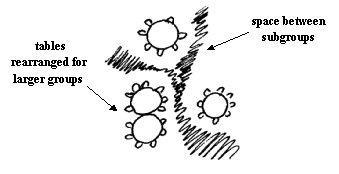
vvv Subgroups work best when they each have their own AGENDA, and when every session has a MOTIVATED MODERATOR. To give each group its identity, place each subgroup's INTIMATE CIRCLE at a reasonable distance from the other groups. . . . |
19 Study Cycle **. . . the group has chosen the literature to study, ordered the literature chronologically (SEQUENTIAL STUDY), and created a group AGENDA. Now the group must consider how newer members will get their chance to study selected works.
Veteran members of a mature group tend to study advanced pieces of literature. This can be a problem for new or prospective members, who need to study earlier, foundational works, before they may contribute meaningfully in dialogues on advanced topics.
Study cycles are primarily created for newer members of a group. Newer
members need to study literature in the same chronological order as
veteran members. Study cycles give them a way to do this, letting
them eventually graduate to other cycles, centered around
later or advanced topics.
Study cycles can also be useful for groups that want to study some
special subject for some period of time. Perhaps only a fraction of
the group is interested in this study. That small group can go off,
create the study cycle, go through the agenda, and then move on, leaving
the study cycle for others who may wish to go through it in the future.
Good study cycles take time and care to create. The trick is to choose
readings that fit together nicely and to formulate and record good
OPENING QUESTIONs for each reading.
Study cycles are often created around specific themes, and may contain
readings of primary literature followed by readings of commentary on
that literature. For the
Design Patterns Study Group of NYC, study cycles have included
blocks of sessions devoted to the study of large object-oriented frameworks.
Without study cycles, it is hard for people who miss certain readings
to ever get the chance to read and discuss them with others. However,
with a study cycle, people can simply wait till a new cycle begins,
and then get their chance to study with others.
The DPSG has built up a study cycle within a SUBGROUP,
which studies a single, classic book. The group ordered the 23 readings
to make the concepts as easy to understand as possible. Each group which
studies this cycle, takes 23 weeks to get through it. After that, there
is a 2-3 break, and then new members may join the subgroup, and begin
the study cycle.
It is interesting to learn why the DPSG formed this study cycle. The DPSG's
senior members realized somtime after they had studied this classic book,
that new members of the group were not getting their chance to study
the book, with other, in a dialogue. This was limiting the number of
new members who would join the group, since many of them needed to study
the classic book, before they could go on to study further works
(SEQUENTIAL STUDY). The study cycle
and subgroup were thus added to accomodate new members, and make
the larger study group a more valuable resource to the community
(in this case, New York City).
IT IS IMPORTANT TO NOTE THAT NOT EVERYTHING A GROUP STUDIES WILL NEED TO BE
IN A STUDY CYCLE. Many works will not be worth studying again, and so
will simply be part of a subgroup's AGENDA, and never make it into STUDY CYCLE -- FIX THIS!!!
Therefore:
Package up groups of readings into a collection, which a group of individuals may undertake to study. Combine the study cycle with a SUBGROUP, which will repeat the cycle over and over as long as their is interest either in the group, or with individuals who wish to join the group.
vvv . . . (ADD THE FOLLOWUP) |
20 Distributed Diary
. . . The POOL OF INSIGHT and VIRTUAL SPACE provide centers where a community may assemble, learn and grow. This pattern enlarges and strengthens that community by giving it the fruits of study group sessions.
Study groups generate valuable ideas, questions and commentary. If this output is not recorded and made public, only attending group members will benefit, leaving everyone else (including members who were not able to attend a session) with nothing.
To present and non-present members of a group, the outside public (including
similar study groups), and to future members of a group, the ideas that surface
during a study session can be quite valuable.
The trouble is, these ideas tend not to be recorded.
The reasons for this usually involve some combination of the following:
Some groups simply choose to let people volunteer to take the minutes at a meeting.
This makes sense, however, in practice, over the many months and years
that a study group may meet, it tends not to work. The trouble is,
the volunteer can only record what they deem to be the most important ideas,
and can easily, and inadvertently, miss recording important ideas.
In addition, and perhaps more important, the individual may want to play
an active role in the dialogue, and may find the act of recording to
be a burden. It has been observed by numerous study groups that sustained,
minutes taking is not an easy task to pull off, despite being valuable
for the group and its community.
Another solution is to use a device, such as a tape recorder, to capture the
contents of a session. This too has problems, since many people would rather
learn about important ideas that surfaced, rather than listening
to a long, unedited, perhaps low-fidelity, recording.
A solution that seems to work consistently for groups is to distribute the
process of capturing important ideas and then let a single volunteer
compile the group's ideas into one document. The process usually works like this:
If the group follows the custom of asking an OPENING QUESTION,
it is a good idea to record this question in the final diary.
For the edification of a study group, and its community, diaries are
placed on VIRTUAL SPACEs.
There is only one point that a group must be on guard about.
(Also, write about giving feedback to authors).
Therefore:
Let all participants capture what they think are the most important ideas, questions or commentary of a study group session. One person will compile the group's observations into a single diary, which may be distributed to all group members.

vvv Important ideas or questions may come up after a session, perhaps during an AFTERHOURS conversation. Keep a ready supply of index cards for recording ideas that may belong in a study session's diary. . . . |
21 Afterhours *
. . . this pattern helps complete what the study group itself is designed to do: foster learning and personal growth (KNOWLEDGE HYDRANT, KINDRED COLLABORATORS).
Sometimes people learn more after a group meets than when a group meets. After meetings, people continue lively dialogues, get to know each other, blow off stream, exchange ideas, and discover opportunities. Yet so many groups fail to include social time.
Since it began as a gathering of friends, the DPSG has always included
a post-meeting "social time". We use this time to eat dinner and have
drinks, to continue the evening's dialogue, to network with each other or to
just laugh about life and work. On some occasions, members of the group
who can't attend a meeting--because of work, family or other engagements--
find time after a meeting to join the group during our social time.
This time spent afterhours is called, in A Pattern Language,
"COMMUNAL EATING". The authors write
that "without communal eating, no human group can hold together." They
quote Thomas Merton, who summarized the idea as follows:

Afterhours time has always been very popular with the DPSG. But a few times, it also served a different purpose: once, a recruiter contacted every member of the group, hoping to be able to attend one of the meetings. We politely informed the recruiter that our meetings where not open to him, but that he would be welcome to join the group afterhours, at the group's favorite hang-out. We also mentioned that it might be nice if the recruiter purchased a round of drinks! After this meeting, a number of DPSGers reported that they had actually enjoyed the meeting, and pointed out how different it was to speak with a recruiter in a social context, rather than on the phone, in the middle of a business day. Therefore: Have unofficial meetings after official meetings. Go someplace fun, easy to get to or within walking distance, where members may eat and drink together, share experiences, network and enjoy each other's company.
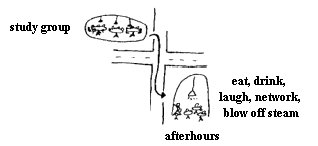
vvv
After a group has been going to the same place for a considerable amount
of time, the group may want to spread out to other locations, preferably
within walking distance. Some groups change restaurants twice a year.
|
References
[Adler1940] Adler, Mortimer. How To Read A Book: The Art Of Getting A Liberal Education.
New York, Simon And Schuster, © 1940. (7th paperback printing, December 1960).
[Adler1983] Adler, Mortimer. How To Speak, How To Listen. New York, Macmillan Publishing Company, © 1983
[Alexander+1977] Alexander, Christopher. A Pattern Language. New York, Oxford University Press, © 1977.
[Bohm1996] Bohm, David. On Dialogue. London, Routledge, © 1996.
[Senge1990] Senge, Peter M. The Learning Organization. New York, Currency Doubleday, © 1990
|
Photo Acknowledgements
1. St. John's College
|
Acknowledgements(list) |